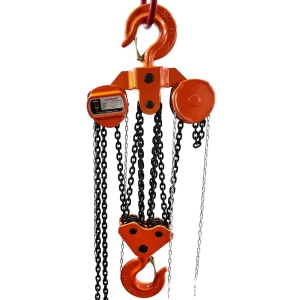A chain hoist is a mechanical device used to lift or lower heavy loads using a system of chains, gears, and a lifting hook. The primary goal of a chain hoist is to provide a mechanical advantage (MA), allowing a user to lift heavy objects with much less effort than would otherwise be required.
Key Components
- Load Chain: The chain that directly supports the load.
- Hand Chain: The chain operated by the user to lift the load.
- Gears: Interconnected gears multiply the force applied by the user.
- Sheaves (or Pulleys): Guide the chain and can influence mechanical advantage.
- Hook: Holds the load securely.
Principle of Operation
A chain hoist works on the principles of mechanical advantage, which are primarily determined by:
- Pulley Systems: Using multiple pulleys reduces the force needed.
- Gear Ratios: Increasing the gear ratio allows less force to lift a load by trading off distance.
- Friction Reduction: Well-lubricated systems ensure that minimal energy is lost to friction.
Factors Affecting Force Requirements
To make a chain hoist require less force, several factors must be optimized:
1. Mechanical Advantage (MA)
Mechanical advantage is the ratio of the load force to the effort force. A higher MA reduces the force needed to lift the load. For chain hoists, this is achieved through:
- Gear Ratios: Increasing the number of teeth on the larger gear relative to the smaller gear provides a higher MA.
- Pulley Configurations: Using multiple pulleys in a block-and-tackle arrangement increases the MA, as the load is distributed across multiple ropes or chains.
2. Load Weight
The heavier the load, the more force is required. However, improving the efficiency of the system can make lifting the same weight easier.
3. Chain Type and Quality
The type and quality of the chain affect the efficiency of force transmission:
- High-grade chains reduce deformation under load.
- Smooth, corrosion-resistant chains reduce friction losses.
4. Friction
Friction in gears, chains, and other moving parts increases the force required. Reducing friction can significantly enhance the ease of operation:
- Use high-quality bearings.
- Regularly lubricate moving parts.
5. User Effort and Ergonomics
The effort applied by the user can be influenced by:
- The length of the hand chain (longer chains allow more leverage).
- Ergonomic design to reduce strain during operation.
Practical Methods to Reduce Force
1. Increasing Gear Ratios
- The gearing mechanism is the heart of a chain hoist. Adding more gears or improving the ratio of the input gear to the output gear can decrease the force required. However, it will increase the number of revolutions needed to lift the load.
2. Using a Multi-Sheave Pulley System
- Adding more pulleys to the system distributes the load across multiple segments of the chain, effectively reducing the force needed to lift the load.
3. Optimizing Chain Design
- Use lighter but stronger chains, such as alloy steel chains, to reduce system weight.
- Ensure chains are free of rust and well-lubricated.
4. Maintenance
- Regularly inspect and maintain the hoist to ensure all parts are working efficiently.
- Replace worn-out parts to prevent increased friction or slippage.
5. Employing Counterweights
- In some advanced systems, counterweights can balance part of the load, reducing the net force required.
6. Reducing Load
- If possible, divide the load into smaller portions and lift incrementally. While this might not directly affect the hoist mechanism, it can reduce physical strain.
7. Utilizing Electric or Pneumatic Assistance
- Add a motorized component to the chain hoist. An electric or pneumatic motor reduces manual effort entirely by converting external energy into lifting force.
Example Calculation: Force Reduction
Let’s calculate the effect of a gear ratio on the required force for a 500 kg load.
- Load Force (F_load):
Fload=Mass×g=500 kg×9.81 m/s2=4905 NFload=Mass×g=500kg×9.81m/s2=4905N - Assume Gear Ratio (R): If the gear ratio is 10:1, the effort force (FeffortFeffort) is:
Feffort=FloadR=4905 N10=490.5 NFeffort=RFload=104905N=490.5N - Effect of Pulleys: Adding a 4-sheave pulley system increases the MA by a factor of 4: Feffort with pulleys=490.5 N4=122.625 NFeffort with pulleys=4490.5N=122.625N
Thus, combining a good gear ratio with a pulley system dramatically reduces the effort force required.
Additional Considerations
Material Selection
- Use lightweight, high-strength materials to construct the hoist. Modern materials like titanium or carbon fiber (for non-load-bearing components) can reduce overall weight and improve ease of handling.
Automation
- Incorporating electronic sensors and automated systems can optimize load distribution and force application. This technology is particularly useful in industrial settings where high loads are common.
Safety Features
- Brake systems prevent the load from falling, reducing the need for additional force to stabilize the load.
- Overload protection ensures the hoist isn’t subjected to more weight than it can handle efficiently.
Energy-Efficient Motors
- For powered hoists, use energy-efficient motors to ensure that external power is utilized optimally, reducing operational costs and effort.
Future Innovations
Advances in engineering might lead to even more efficient designs, such as:
- Smart Hoists: Integrating IoT technology to monitor load and adjust force dynamically.
- Magnetic-Assisted Lifting: Utilizing magnetic fields to supplement lifting force.
- Advanced Lubricants: Developing frictionless materials for gears and chains.
Conclusion
Reducing the force required to operate a chain hoist involves optimizing mechanical advantage through improved gear ratios, pulley systems, material selection, and maintenance. By understanding the fundamental principles and leveraging modern technology, chain hoists can become even more efficient, enabling users to lift heavy loads with minimal effort. These improvements not only enhance functionality but also promote safety, longevity, and usability in diverse applications.

